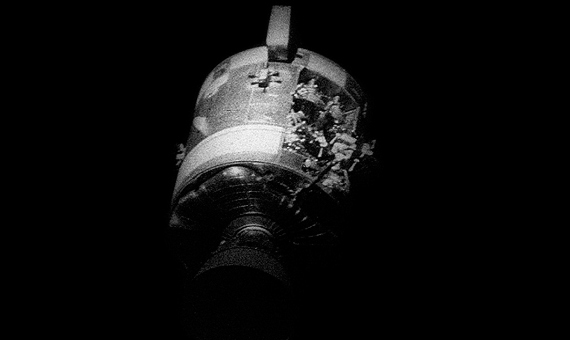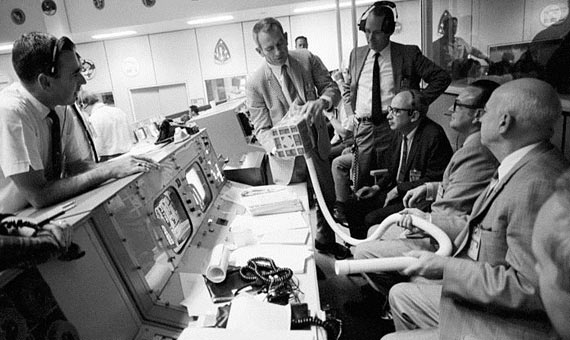“Houston, we have a problem.” The famous quote has become a popular phrase applied to almost any situation. Those who were alive then may well remember the Apollo 13 mission as a space thriller with a happy ending. Those who have come across the story through subsequent recreations, notably Ron Howard’s 1995 film, might remember that the success of the rescue involved squaring the circle.
But the adventure of Apollo 13 was much more than that. The problems cropped up one after another, followed by solutions that were thought up one after another, in a brilliant example of crisis management and teamwork.

On April 11, 1970, the third of the manned missions to the lunar surface blasted off from the Kennedy Space Center with three astronauts on board: Commander James A. Lovell, Lunar Module Pilot Fred W. Haise, and Command Module Pilot John L. “Jack” Swigert, who was to remain in orbiting around the Moon while his two companions explored the lunar formation called Fra Mauro.
Almost 56 hours after the launch, when the ship was about 330,000 kilometres from Earth, the crew of the Apollo 13 heard a loud bang. While reporting the problem to the control centre—”Houston, we had a problem,” was the original phrase—the oxygen level of tank 2 dropped to nothing.
‘Odyssey’ mission
Among those who heard that distress call was Jerry Woodfill, the Johnson Space Center engineer in charge of the Apollo 13 warning systems. Woodfill saw the flash of the main alarm before hearing the words of Swigert and Lovell. What followed, as the alarms began to sound one after the other before Woodfill’s eyes, led to an anguished conclusion: the mission could not be completed, and the recovery of the astronauts was going to live up to the name with which the command module of the Apollo 13 had been baptized: Odyssey.
The ship en route to the Moon consisted of three parts. The Odyssey command module was the capsule—the passenger compartment for the astronauts during the voyage to the Moon and the return to Earth. This module was joined to two other devices: on its nose was the lunar module Aquarius, in which Lovell and Haise were supposed to descend to the Moon. At the opposite end, the Odyssey was attached to the service module, a non-pressurized cylindrical structure that housed the systems required by the command module and which had to be decoupled on its return, before re-entry into the atmosphere.
The service module carried fuel cells made up of hydrogen and liquid oxygen, which combined to supply drinking water and power the Odyssey, in addition to providing breathable air. Following the explosion of one of the oxygen tanks and the loss of the other, the fuel cells failed, leaving the astronauts with an insufficient supply of water, energy and oxygen to complete their plan.
“Failure was not an option”
The mission had to be aborted, and as Woodfill points out to OpenMind, paraphrasing a promotional motto from Ron Howard’s film, “failure was not an option.” Three years earlier, the Apollo 1 capsule had burned on the launch pad because of an electrical fault, killing its three crewmembers. “The tragedy of Apollo 1, I believe, led to that deeply felt resolve in all who continued to work to put the first men on the Moon,” says Woodfill.

But the obstacles to overcome were considerable. The mission controllers in Houston decided to maintain the spacecraft’s trajectory to return to Earth, taking advantage of the lunar gravity boost. The astronauts had to leave the Odyssey and move to the Aquarius, which had enough water, oxygen and supply batteries, provided they were rationed drastically.
Soon after, the mission’s most memorable problem arose when another of Woodfill’s alarms warned that the CO2 emitted by the astronauts’ breathing was beginning to accumulate in the Aquarius at dangerous levels. Engineers in Houston were required to design an emergency procedure so that Lovell and his fellow crewmembers could adapt the Odyssey’s square CO2 absorbers to the circular holes of the Aquarius. “Even if every available round lunar module filter were used, the crew would not have survived without the duct taped apparatus,” says Woodfill.
However, the problems did not end there. When the astronauts set out to align the ship for re-entry into the atmosphere, they discovered that the usual method was impracticable: the remnants of the explosion that traveled around them made it impossible to orient themselves by the stars, so they had to be guided by the Sun. In addition, procedures had to be improvised to transfer energy from the Aquarius batteries to the Odyssey, and then to eject the former at a prudent distance that would allow the command module to clear its re-entry route.
Re-entering the atmosphere
When the astronauts returned to the Odyssey —to re-enter the atmosphere and prepare for landing— the cold temperature in its interior had condensed so much water vapor in the devices that the reactivation of the energy supply could have caused a new and fatal electrical failure. “Powering up those circuits might very well have resulted in the same kind of short-circuit which led to the demise of the Apollo 1 crew,” says Woodfill. And thanks to the work of this engineer, also responsible for the wiring of the panels, at least the death of the three crew members of the first Apollo mission was not in vain: after that tragedy, Woodfill explains, not only were the alarm systems improved, but also the electrical connectors under the panels were coated with a substance that insulated them against moisture. “In my mind, this saved Apollo 13,” he says proudly. The Odyssey landed in the South Pacific on April 17, with its three occupants safe and sound.

The investigation after the accident managed to unravel the cause. The liquid oxygen tanks had a heater to turn the contents into gas, controlled by a thermostat. Due to a change in the technical specifications, the power supply of these devices had risen from 28 to 65 volts, but the thermostats were not prepared for this excess voltage and melted, preventing the heater from being switched off. The temperature rise melted the Teflon insulation of the fan wires of the second oxygen tank, causing a short circuit.
The happy ending did not prevent Woodfill and the rest of the engineers from undertaking a thorough overhaul of the systems. Among many other changes, the thermostats were updated, fans were removed and a third oxygen tank was added. Four more missions successfully flew to the Moon. “All later Apollo missions profited from the Apollo 13 rescue,” Woodfill concludes.
Comments on this publication